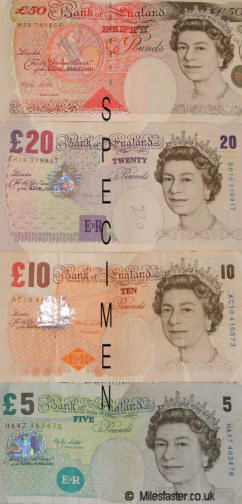What Currency Is Used In England
Prior to Feb 15th 1971 the British currency system was known as pounds, shillings and pence. In the system used at that time 12 pennies was equal to one shilling and 20 shillings was equal to one pound. After February 15th 1971 the UK moved to a new system called decimalisation and brought the currency into line with the metric systems used in Europe which are based on a logical system of 10 or factors of 10's. So with decimalisation came a organisation of pounds and pence doing away with shillings altogether. Britain currency is known as BRITISH STERLING.
Under this arrangement 100 pence is equal to one pound making working with the UK currency far easier. The symbol used for pounds is: £ or is sometimes shown as GBP (Great britain Pounds) and the symbol used for pence is: p
So two pound forty pence would be written: £2.40 or GBP 2.40
Twenty pence would be written 20p.
Currently the currency in use is every bit follows:
coins: 1 penny, 2 pence, 5 pence, x pence, 20 pence, 50 pence, one pound, 2 pounds. The 1 penny and 2 pence piece are statuary, the five, 10, twenty and l pence pieces are silver and the ane and 2 pound coins are gold. All coins bear the Queens head on the front end.
 alt="Great britain Coins">
alt="Great britain Coins">
notes in 2005: 5 pounds, 10 pounds, 20 pounds, fifty pounds. Front view.

Like the Great britain coins the notes all conduct the Queens head. They likewise carry a watermark that is visible to the eye only when held up to the lite. The watermark is the Queens head and shows in the egg shaped white space on all the above notes. There is also a argent strip that shows when held up to the light along the width of the notes.
New Five Pound Annotation
On September 13th 2016 the UK got its first plastic notation, the new five pound notation. xv% smaller than the older traditional paper type in utilise at the fourth dimension. Its fabricated from a material called polymer which is a flexible thin plastic. The old five pound note no longer beingness legal tender after May 2017. The new version will final 2.5 times longer making them better value. On the dorsum is the face up of Winston Churchill along with his famous quote of "I take zip to offer but blood, toil, tears and sweat". While the front end is nevertheless Queen Elizabeth Ii.

New 50 Pound
On the 2nd August 2011 a new £50, designed by Chris Salmon, was issued. The notation every bit usual shows the Queen on one side while the other side shows Matthew Boulton and engineer James Watt. Matthew Boulton was a concern entrepreneur from the 18th century while James Watt was an engineer perhaps best known for his part in inventing the separate condenser, an improvement on the Newcomen steam engine. Known equally an 'F' series annotation, the first of which was the twenty pound note issues in 2007 (see below). This is the first bank annotation in the Great britain to feature two portraits on the reverse side.

New Xx Pound Note:
On the 13th March 2007 a new £xx notation was issued past the depository financial institution of England. The last time this annotation was replaced was 1999. When new notes are issued the onetime ones continue to be legal tender for a considerable time. Fifty-fifty afterwards that you can nevertheless exchange the old notes for new ones at UK banks. In this case the older fashion £20 note was withdrawn on June 30th 2010.
The new style notation shows the image of Adam Smith (eighteenth century economist) which makes him the beginning Scottish citizen to be shown on a UK banking company note. The changes over the last £20 note include a lighter shade of imperial and several security enhancements. For example raised lettering and larger hologram and a new security colour tag which shows upwards under ultra-violet low-cal. Interestingly the £20 annotation is the almost unremarkably used notation.

The Great britain is does not use the same currency every bit much of Europe contrary to the belief of many get-go time visitors. While many countries of the European spousal relationship use the Euro which came into being on January 1st 1999 the U.k. has and then far decided to keep with its own currency.
Confusingly while the Currency above is issued past the Depository financial institution of England and is the official currency for the UK, other banks practise issue their own notes. This applies to Scotland and Northern Ireland with the banks issuing notes beingness:
Scotland: Clydesdale Bank, Royal Depository financial institution of Scotland and Banking company of Scotland
Northern Ireland: The Depository financial institution of Ireland Commencement Trust Depository financial institution Northern Banking company Ulster Banking company
These banks produce £100 notes which are not produced by the Bank of England.
Many people exterior of Northern Ireland and Scotland are not familiar with these local notes and they are sometimes refused as adequate payment in England. Still they are perfectly acceptable as payment anywhere in the United kingdom of great britain and northern ireland.
An frequently used slang term used to refer to U.k. pounds is quid.
What Currency Is Used In England,
Source: https://milesfaster.co.uk/information/uk-currency.htm
Posted by: sancheznernat.blogspot.com


0 Response to "What Currency Is Used In England"
Post a Comment